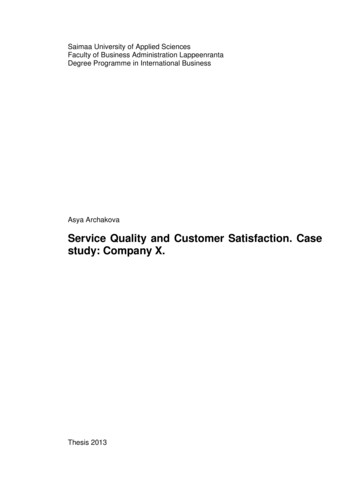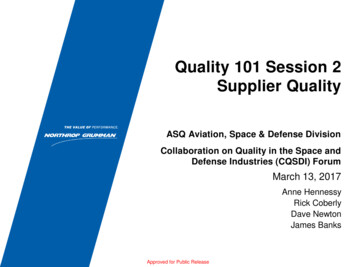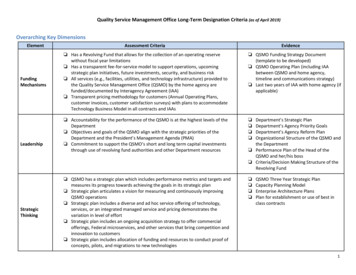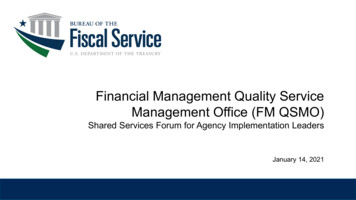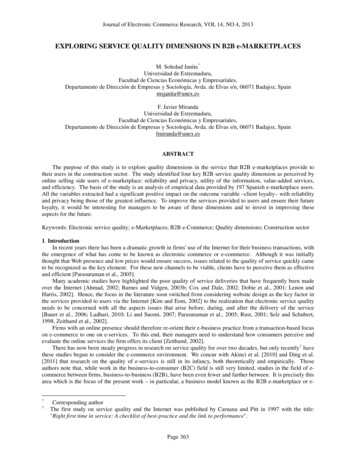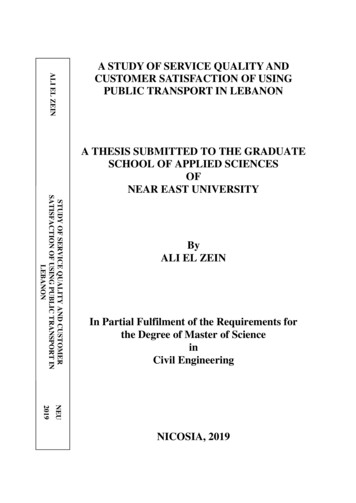
Transcription
ZEINALI EL K.AHAMEDMOSTAFAA STUDY OF SERVICE QUALITY ANDCUSTOMER SATISFACTION OF USINGPUBLIC TRANSPORT IN LEBANONSTUDY OF SERVICE QUALITY AND CUSTOMERSATISFACTION OF USING PUBLIC TRANSPORT INLEBANONA THESIS SUBMITTED TO THE GRADUATESCHOOL OF APPLIED SCIENCESOFNEAR EAST UNIVERSITYByALI EL ZEINIn Partial Fulfilment of the Requirements forthe Degree of Master of ScienceinCivil EngineeringNEU2019NICOSIA, 2019
STUDY OF SERVICE QUALITY AND CUSTOMERSATISFACTION OF USING PUBLIC TRANSPORT INLEBANONA THESIS SUBMITTED TO THE GRADUATESCHOOL OF APPLIED SCIENCESOFNEAR EAST UNIVERSITYByALI EL ZEINIn Partial Fulfilment of the Requirements forthe Degree of Master of ScienceinCivil EngineeringNICOSIA, 2019
Ali EL Zein: STUDY OF SERVICE QUALITY AND CUSTOMERSATISFACTION OF USING PUBLIC TRANSPORT IN 11111111Approval of Director of Graduate School ofApplied f. Dr. Nadire 1111111111We certify that, this thesis is satisfactory for the award of the degree of Masterof Science in Civil mining Committee in Charge:Prof. Dr. Hüseyin GÖKÇEKUŞ11111Dr. Shaban Ismael ALBRKA11111Asst. Prof. Dr. Anoosheh IRAVANIAN111111Asst. Prof. Dr. Youssef KASSEM11111Dr. CAN KARACo- Supervisor, Chairman of the jury, Deanof Faculty of Civil and EnvironmentalEngineering, NEU11Supervisor, Department of Civil Engineering,NEU111Vice Chairman of Department of CivilEngineering, NEU111Department of Civil Engineering, NEU111Department of Architecture Engineering,NEU
I hereby declare that all information in this document has been obtained and presented byacademic rules and ethical conduct. I also declare that, as required by these rules andconduct, I had fully cited and referenced all material and results that are not original to thiswork.Name, Last name: Ali El ZeinSignature:Date:
ACKNOWLEDGEMENTSFirst and always, I would thank God for giving me the strength to finish this work.Semesters has passed; I had some good days, and other hard days, whenever I was down,God has always given me hope and strength to continue. This thesis would not be donewithout the support and patience of my supervisor Dr. SHABAN ISMAEL ALBRKA andmy Co-supervisor Prof. Dr. Hüseyin GÖKÇEKUŞ for his constant encouragement andguidance. They had guided me through all the stages of the writing of my thesis. Withouttheir consistent and illuminating instruction, this thesis could not have reached its presentform.Thanks are due to all the staff and Management, Faculty of Civil Engineering Department,NEU, especially Prof. Dr. Hüseyin GÖKÇEKUŞ and Dr. SHABAN ISMAEL ALBRKA toassisting me on various occasions. My sincere appreciation also extends to all my familymembers especially my Father, Mother, and my brothers for their understanding andencourage me all the time until complete on this research project.I am also indebted to the librarians at Near East University (NEU) for their help insupplying the relevant literature, and lastly, I wish to express my sincere appreciation to allthe people that assisted throughout the preparation for this Thesis.ii
To my parents
ABSTRACTLebanon is one of few countries in the world with a non-organized public transportationsector, were public vehicles move freely without any regulations or planning. The increaseof country population causes an increase in travel demands. Now a day Lebanon is facingan explosive growth in private vehicles ownership turning its roads to a huge parking area.Public transportation is considered a major solution to these problems. The aim of thisstudy is to verify the quality of service infrastructure in the public transport of Lebanesebuses in order to give priority to improving quality in the future. In this study 384questionnaires were distributed in Greater Beirut area (GBA), Saida and Tripoli, as theyare the most crowded population area in Lebanon and the data were analyzed by Statisticalpackages for science scientists (SPSS) software. The study found that overall commuter’ssatisfaction is impacted by service quality factors. The results showed a high percentage of“not satisfying” 59.9% for “schedule and timetable” factor, 49.2% for “attractive and neatoffice” and 46.6% for “feeling safe during a transaction with staff”. While the highpercentage of extremely satisfied was around 15%. The results of correlation analysisrecommend 5 factors that have a strong relationship with each other which are “arriving ontime”, “scheduled timetable”, “feel safe”, “bus comfort” and “maintenance”.Keyword: Lebanon; public bus transport; service quality; survey; bus serviceiv
ÖZETLübnan, toplu taşımacılık sektöründe planlama, düzenleme ve yönetme alanında dünyadageri kalmış ülkeler arasında gözlemlenmektedir. Planlama ve organizasyon alanındakinoksanlar bireylerin şahsi araç kullanımı tercih etmesine sebep olup, artan nüfüs ve araçsayısı ile birlikte ülkede caddeler devasa park alanlarına dönüşmüştür. Otobüsle toplutaşımacılık ise mevcut problemin çözümü için etkili bir yöntem olarak görülmektedir.Yapılan çalışmada amaç, mevcut toplu taşımacılık altyapısı ve servis kalitesinideğerlendirmek ve ülkede toplu taşımacılık potansiyelinin gelişmesine ışık tutmaktır.Araştırma kapsamında, nüfüs yoğunluğu yüksek olan bölgeler ele alınıp, Beyrut (GBA),Saida ve Tripoli bölglerinde toplam 384 anket gerçekleştirilmiştir. Anket sonucunda eldeedilen veriler SPSS yazılımı kullanılarak analiz edilmiştir. Çalışmada, hizmet kalitesinintoplu taşıma kullanıcılarının değerlendirmesinde etkili bir faktör olduğu gözlemlenmiştir.Analiz sonuçlarına göre, sırası ile, %59.9 güzergah çizelgesi ve sefer saatleri, %49,2 biletofislerinin cezbediciliği ve %46,6 toplu taşıma personeli ile iletişimde yaşanan güvensizlikgibi faktörler başlıca toplu taşıma kullanıcılarının memnun kalmadığı hizmetler olarakdeğerlendirilmiştir. Buna karşılık, %15 yolcuların toplu taşımada sunulan hizmetlerdentatminkar kalmış olduğu gözlemi analiz sonuçlarında ortaya çıkmıştır. Korelasyon analizisonucunda ise etken faktorler içerisinde güzergah ve çizelge planlaması, sefer saatleriplanlaması ve planlamaya bağlı kalınması, yolcu güvenliği, toplu taşıma araçlarınınbakımlı durumda olması ve yüksek seviye yolcu komforu sağlaması faktorleri arasındagüçlü korelasyon bulunmuştur.Anahtar kelimeler: Lübnan; toplu taşıma; hizmet kalitesi; anket; otobüs servisiv
TABLE OF CONTENTSACKNOWLEDGEMENTS . iiABSTRACT .ivÖZET . vTABLE OF CONTENTS .viLIST OF TABLE .ixLIST OF FIGURES . xiiLIST OF ABBREVIATIONS .xivCHAPTER 1: INTRODUCTION1.1 Background .151.2 Lebanese Public Transportation Overview . 161.3 Problem Statement .171.4 Objectives of Study . 201.5 The scope .20CHAPTER 2 : LITERATURE REVIEW2.1 Introduction .212.2 Service Quality and Customer Satisfaction . 212.2.1 Customer Satisfaction . 212.2.2 Service Quality . 222.3 The Service in Public Industry.272.3.1 Quality Service in Public Transportation Sector .272.4 Empirical Literature Review .28CHAPTER 3 : METHODOLOGY3.1 Introduction .303.2 Methodology of Study . 303.3 Collecting Data .30vi
3.4 Respondents and Sample Size .303.4 Data measurement .323.5 Questionnaire .333.5.1 Design of Questionnaire .333.6 Study Area .343.7 Procedure .353.8 Data analysis .363.9 Validity and Reliability . 363.9.1 Validity of Questionnaire .363.9.2 Reliability of Questionnaire .373.10 Cronbach’s Coefficient Alpha .373.11 Statistical Analysis Tools. 38CHAPTER 4 : RESULTS AND DISCUSSION4.1 Personal data of participants in the questionnaire .394.2 Reliability Statistics Analysis .414.3 Analysis of Dimensions . 414.3.1 Analysis of questions related to Reliability. 414.2.2 Analysis of questions related to Assurance . 484.3.3 Analysis of questions related to Tangibles . 544.2.4 Analysis of questions related to Empathy . 634.2.5 Analysis of questions related to Responsiveness .68CHAPTER 5 : CONCLUSIONS AND RECOMMENDATIONS5.1 Introduction .745.2. Conclusion .755.3 Recommendation .76vii
5.4 Limitation of Thesis . 765.5 Future Research .77REFERENCES .78APPENDIX .81viii
LIST OF TABLETable 3.1:Likert scale . 32Table 3.2: Reliability statistics of each dimension of service quality in public bustransport . 37Table 4.1: Frequency and Percentage of Ages of participants . 39Table 4.2: Frequency and Percentage of qualification of participants . 40Table 4.3: Reliability Statistics of the overall dimension of service quality in publictransport. . 41Table 4.4: Frequency and Percentage of Q1 “The bus always ar
Table 4.34: Mean and Std. deviation of Q18, Q19, Q20 and Q21 . 67 Table 4.35: T value test of Q18, Q19, Q20, and Q21. 68 Table 4.36: Correlation coefficient of Q18, Q19, Q20 and Q21 . 68
